- Recent Articles
- Most Citedi
- Most Viewedi
- Artigos Futuros
-
RESEARCH01-01-2017
The family in face of the elderly’s reality of living alone
Revista Brasileira de Enfermagem. 2017;70(2):235-241
Views0PlumX Metrics
- Citations
- Citation Indexes: 9
- Usage
- Full Text Views: 13811
- Abstract Views: 511
- Captures
- Readers: 54
- Social Media
- Shares, Likes & Comments: 5


This is an Open Access article distributed under the terms of the Creative Commons Attribution License, which permits unrestricted use, distribution, and reproduction in any medium, provided the original work is properly cited. Abstract
RESEARCHThe family in face of the elderly’s reality of living alone
Revista Brasileira de Enfermagem. 2017;70(2):235-241
DOI 10.1590/0034-7167-2016-0398
Views0See moreABSTRACT
Objective:
to understand the family dynamics in face of the reality of the elderly living alone.
Method:
study of qualitative approach with theoretical reference of symbolic interactionism that involved interviews with families. Data were analyzed by thematic analysis.
Results:
six families participated in the study. The discourse analysis originated the following categories: The family respecting their decision making; The family organizing itself to the process of living alone after the age of 80 years; The family experiencing the freedom of living alone.
Conclusion:
in this study, it was possible to identify the facilitation of the possibility of living alone with preparation and agreements between the family during the family life cycle, leading to the feeling of freedom and quality of life of all members. Nursing, as a science responsible for elaborating care strategies, should work together with families to assist in the planning of care plans based on the individual social reality of the family.
PlumX Metrics
- Citations
- Citation Indexes: 9
- Usage
- Full Text Views: 13811
- Abstract Views: 511
- Captures
- Readers: 54
- Social Media
- Shares, Likes & Comments: 5


This is an Open Access article distributed under the terms of the Creative Commons Attribution License, which permits unrestricted use, distribution, and reproduction in any medium, provided the original work is properly cited. 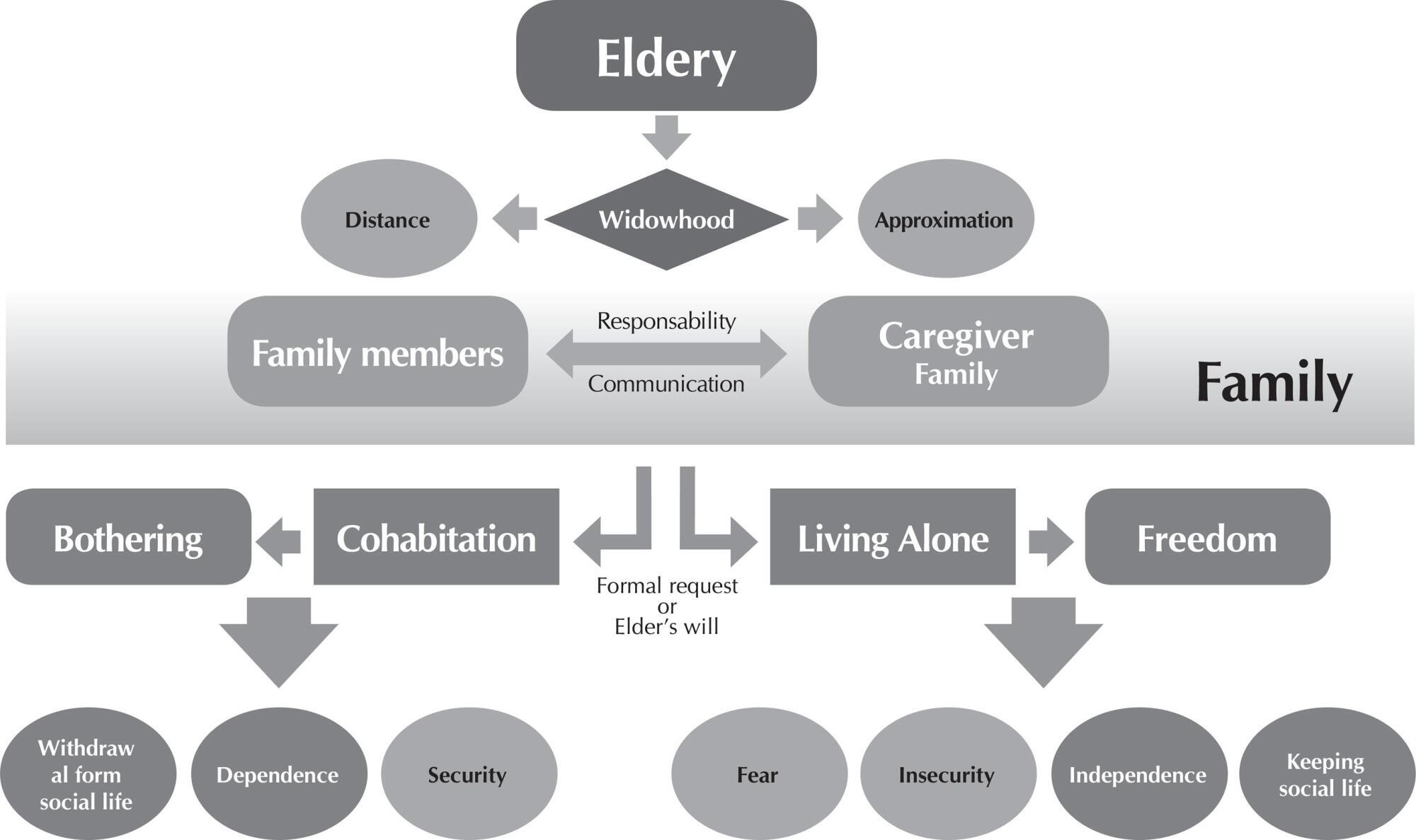
-
LETTER TO THE EDITOR01-01-2017
Dimensioning the instrumentation: Exploratory or confirmatory factor analysis?
Revista Brasileira de Enfermagem. 2017;70(2):233-234
Views0PlumX Metrics
- Citations
- Citation Indexes: 17
- Usage
- Full Text Views: 22719
- Abstract Views: 2187
- Captures
- Readers: 126


This is an Open Access article distributed under the terms of the Creative Commons Attribution License, which permits unrestricted use, distribution, and reproduction in any medium, provided the original work is properly cited. Abstract
LETTER TO THE EDITORDimensioning the instrumentation: Exploratory or confirmatory factor analysis?
Revista Brasileira de Enfermagem. 2017;70(2):233-234
DOI 10.1590/0034-7167-2016-0183
PlumX Metrics
- Citations
- Citation Indexes: 17
- Usage
- Full Text Views: 22719
- Abstract Views: 2187
- Captures
- Readers: 126


This is an Open Access article distributed under the terms of the Creative Commons Attribution License, which permits unrestricted use, distribution, and reproduction in any medium, provided the original work is properly cited. -
01-01-2017Revista Brasileira de Enfermagem. 2017;70(2):233-234
Views0PlumX Metrics
- Citations
- Citation Indexes: 17
- Usage
- Full Text Views: 22719
- Abstract Views: 2187
- Captures
- Readers: 126


This is an Open Access article distributed under the terms of the Creative Commons Attribution License, which permits unrestricted use, distribution, and reproduction in any medium, provided the original work is properly cited. Abstract
Revista Brasileira de Enfermagem. 2017;70(2):233-234
DOI 10.1590/0034-7167-2016-0183
PlumX Metrics
- Citations
- Citation Indexes: 17
- Usage
- Full Text Views: 22719
- Abstract Views: 2187
- Captures
- Readers: 126


This is an Open Access article distributed under the terms of the Creative Commons Attribution License, which permits unrestricted use, distribution, and reproduction in any medium, provided the original work is properly cited. -
01-01-2017
Viral hepatitis: a challenge for nursing
Revista Brasileira de Enfermagem. 2017;70(2):231-232
Abstract
Viral hepatitis: a challenge for nursing
Revista Brasileira de Enfermagem. 2017;70(2):231-232
DOI 10.1590/0034-7167.2017700201
Views0The 20th century unveiled the mystery of the etiology of viral hepatitis, with the identification of five different agents responsible for these infections: the hepatitis A virus (HAV), hepatitis B virus (HBV), hepatitis C virus (HCV), hepatitis D virus (HDV), and hepatitis E virus (HEV). These viruses account for one million deaths every year. HBV, […]See more

This is an Open Access article distributed under the terms of the Creative Commons Attribution License, which permits unrestricted use, distribution, and reproduction in any medium, provided the original work is properly cited. -
01-01-2017
Hepatites Virais: um desafio para enfermagem
Revista Brasileira de Enfermagem. 2017;70(2):231-232
Abstract
Hepatites Virais: um desafio para enfermagem
Revista Brasileira de Enfermagem. 2017;70(2):231-232
DOI 10.1590/0034-7167.2017700201
Views0O século XX desvendou os mistérios sobre a etiologia das hepatites virais, identificando cinco agentes distintos responsáveis por essas viroses: vírus da hepatite A (HAV), vírus da hepatite B (HBV), vírus da hepatite C (HCV), vírus da hepatite D (HDV) e vírus da hepatite E (HEV). Esses vírus são responsáveis por um milhão de mortes […]See more

This is an Open Access article distributed under the terms of the Creative Commons Attribution License, which permits unrestricted use, distribution, and reproduction in any medium, provided the original work is properly cited. -
01-01-2017
ERRATUM
Revista Brasileira de Enfermagem. 2017;70(1):242-242
Abstract
ERRATUM
Revista Brasileira de Enfermagem. 2017;70(1):242-242
DOI 10.1590/0034-7167.20177001e01
Views0Article “Accessibility assessment of assistive technology for the hearing impaired”, with number of DOI: , published in the journal Revista Brasileira de Enfermagem, v69(5):781-7, page 781 that read:“Luciana Vieira de CaravalhoI”.[…]See more

This is an Open Access article distributed under the terms of the Creative Commons Attribution License, which permits unrestricted use, distribution, and reproduction in any medium, provided the original work is properly cited. -
01-01-2017
From silence to voice: book review
Revista Brasileira de Enfermagem. 2017;70(1):240-241
Abstract
From silence to voice: book review
Revista Brasileira de Enfermagem. 2017;70(1):240-241
DOI 10.1590/0034-7167-2016-0066
Views1The book() is a translation of the original titled From silence to voice(), published by Cornell Paperbacks in 2006. Bernice Burech and Susanne Gordon are journalists and took the nursing profession as the object of study. The authors have diagnosed silence in the profession, which motivated writing a work valuing the use of all types […]See more

This is an Open Access article distributed under the terms of the Creative Commons Attribution License, which permits unrestricted use, distribution, and reproduction in any medium, provided the original work is properly cited. -
01-01-2017
Reflections in the light of the complexity theory and nursing education
- Ronny Anderson de Oliveira Cruz,
- Elidianne Layanne Medeiros de Araujo,
- Neyce de Matos Nascimento,
- Raquel Janyne de Lima,
- Jael Rúbia Figueiredo de Sá França, [ … ],
- Jacira dos Santos Oliveira
Abstract
Reflections in the light of the complexity theory and nursing education
Revista Brasileira de Enfermagem. 2017;70(1):236-239
DOI 10.1590/0034-7167-2016-0239
- Ronny Anderson de Oliveira Cruz,
- Elidianne Layanne Medeiros de Araujo,
- Neyce de Matos Nascimento,
- Raquel Janyne de Lima,
- Jael Rúbia Figueiredo de Sá França,
- Jacira dos Santos Oliveira
Views0See moreABSTRACT
Objective:
to reflect on nursing education, taking into account the principles of complex thinking proposed by Morin.
Method:
reflection based on the principles of the complexity theory by Edgar Morin.
Results:
the application of complexity in teaching proposes an emancipatory education based on questioning and social transformation. It comprises the education of nurses who interact with others as a characteristic of their work. It is necessary to prepare students to develop critical and reflective attitudes and actions to overcome the fragmentation and linearity of knowledge.
Conclusion:
nursing care has been based on a reductionist assistance, reflecting the Cartesian model. Thus, nursing education seeks to comprise shared knowledge and experiences so that no subject or professional overpowers another, accepting the uniqueness of professionals and patients.


This is an Open Access article distributed under the terms of the Creative Commons Attribution License, which permits unrestricted use, distribution, and reproduction in any medium, provided the original work is properly cited.
-
REVIEW07-29-2022
Technologies used by nursing to predict clinical deterioration in hospitalized adults: a scoping review
- Érica Sobral Gondim
 ,
, - Emiliana Bezerra Gomes
 ,
, - José Hiago Feitosa de Matos
 ,
, - Sarah de Lima Pinto
 ,
, - Célida Juliana de Oliveira
 , [ … ],
, [ … ], - Ana Maria Parente Garcia Alencar

Abstract
REVIEWTechnologies used by nursing to predict clinical deterioration in hospitalized adults: a scoping review
Revista Brasileira de Enfermagem. 2022;75(5):e20210570
DOI 10.1590/0034-7167-2021-0570
- Érica Sobral Gondim
 ,
, - Emiliana Bezerra Gomes
 ,
, - José Hiago Feitosa de Matos
 ,
, - Sarah de Lima Pinto
 ,
, - Célida Juliana de Oliveira
 ,
, - Ana Maria Parente Garcia Alencar

Views1See moreABSTRACT
Objective:
to map the early clinical deterioration technologies used in nurses’ professional practice in the care of hospitalized adult patients.
Methods:
this is a scoping review, according to Joanna Briggs Institute Reviewer’s Manual, which seeks to map the main technologies for detecting early clinical deterioration of hospitalized patients available for use by nurses, summarizing them and indicating gaps in knowledge to be investigated.
Results:
twenty-seven studies were found. The most present variables in the technologies were vital signs, urinary output, awareness and risk scales, clinical examination and nurses’ judgment. The main outcomes were activation of rapid response teams, death, cardiac arrest and admission to critical care units.
Final considerations:
the study emphasizes the most accurate variables in patient clinical assessment, so that indicative signs of potential severity can be prioritized to guide health conducts aiming to intervene early in the face of ongoing clinical deterioration.


This is an Open Access article distributed under the terms of the Creative Commons Attribution License, which permits unrestricted use, distribution, and reproduction in any medium, provided the original work is properly cited. 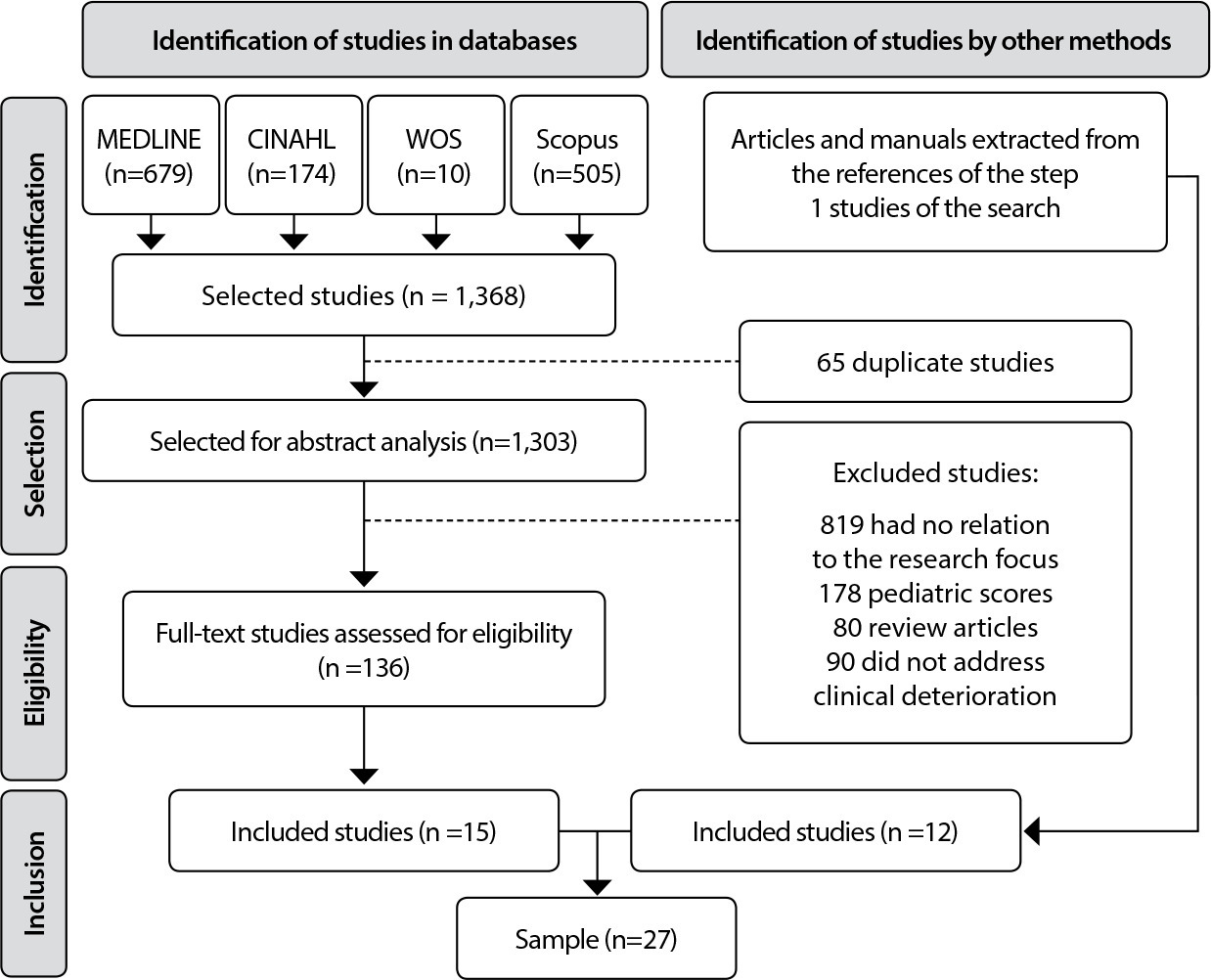
- Érica Sobral Gondim
-
ORIGINAL ARTICLE05-09-2022
Core competencies for the training of advanced practice nurses in oncology: a Delphi study
Revista Brasileira de Enfermagem. 2022;75(5):e20210573
Abstract
ORIGINAL ARTICLECore competencies for the training of advanced practice nurses in oncology: a Delphi study
Revista Brasileira de Enfermagem. 2022;75(5):e20210573
DOI 10.1590/0034-7167-2021-0573
Views0See moreABSTRACT
Objective:
To map out and validate the core competencies for the training of advanced practice nurses in oncology.
Methods:
Exploratory-descriptive research with a quantitative approach using the Delphi technique. Initially, a matrix composed of six domains outlining 112 core competencies of the clinical nurse specialist in oncology was elaborated. The Likert scale was used to measure the degree of agreement. Data collection took place through the Google Forms® platform from February to May 2021. Data were compiled and analyzed based on expert suggestions and literature.
Results:
100 competencies achieved consensus (agreement level above 85.7%) in the first round; 13 new competencies were proposed by expert members; and 125 were validated during the Delphi technique.
Conclusion:
The mapping and validation of core competencies will allow the development of new training models aimed at advanced practice in oncology and future educational harmonization.


This is an Open Access article distributed under the terms of the Creative Commons Attribution License, which permits unrestricted use, distribution, and reproduction in any medium, provided the original work is properly cited. 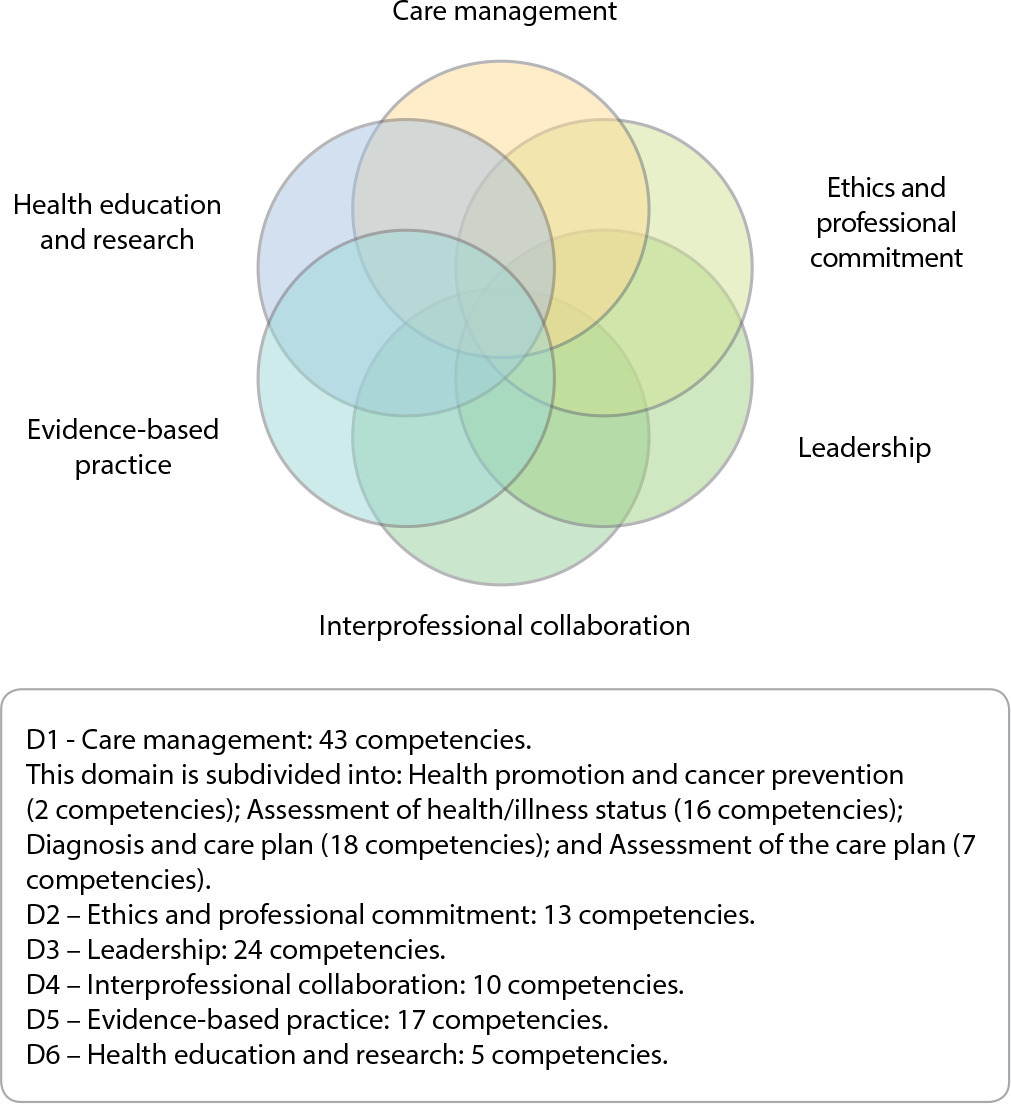
-
ORIGINAL ARTICLE10-21-2022
Technology for nursing consultation with transsexual women in the light of Leininger’s transcultural theory
- Josueida de Carvalho Sousa
 ,
, - Ednaldo Cavalcante de Araújo
 ,
, - Eliane Maria Ribeiro de Vasconcelos
 ,
, - Nelson Miguel Galindo-Neto
 ,
, - Marclineide Nóbrega de Andrade Ramalho
 , [ … ],
, [ … ], - Paula Daniella de Abreu

Abstract
ORIGINAL ARTICLETechnology for nursing consultation with transsexual women in the light of Leininger’s transcultural theory
Revista Brasileira de Enfermagem. 2022;75(5):e20210769
DOI 10.1590/0034-7167-2021-0769
- Josueida de Carvalho Sousa
 ,
, - Ednaldo Cavalcante de Araújo
 ,
, - Eliane Maria Ribeiro de Vasconcelos
 ,
, - Nelson Miguel Galindo-Neto
 ,
, - Marclineide Nóbrega de Andrade Ramalho
 ,
, - Paula Daniella de Abreu

Views0See moreABSTRACT
Objective:
to describe the construction and validation of a nursing consultation technology for transgender women.
Methods:
a methodological study developed in three stages with construction based on the Leininger’s Cross-Cultural Theory, content validation performed by experts in transgender sexual health and evaluation by nurses of care for transgender women. Items with a minimum agreement of 80% were considered validated, according to the Content Validity Index and binomial test.
Results:
the technology contains 59 items in three blocks: the first, for identification of the transsexual woman; the second, with the Clinical Data; and the third, regarding the Propaedeutics of Care. All items reached agreement higher than 0.8 and an overall Validity Index of 80%.
Conclusions:
the technology was content-validated and evaluated by nurses and can be applicable in clinical and outpatient practice as well as in academia to promote quality care for transgender women.


This is an Open Access article distributed under the terms of the Creative Commons Attribution License, which permits unrestricted use, distribution, and reproduction in any medium, provided the original work is properly cited. - Josueida de Carvalho Sousa
-
ORIGINAL ARTICLE07-22-2022
Cross-cultural adaptation, validation and reliability of the Medication Safety Thermometer tool for use in Brazil
Revista Brasileira de Enfermagem. 2022;75(5):e20210839
Abstract
ORIGINAL ARTICLECross-cultural adaptation, validation and reliability of the Medication Safety Thermometer tool for use in Brazil
Revista Brasileira de Enfermagem. 2022;75(5):e20210839
DOI 10.1590/0034-7167-2021-0839
Views0See moreABSTRACT
Objectives:
to perform cross-cultural adaptation, face and content validation and reliability analysis of the Medication Safety Thermometer tool for use in Brazil.
Methods:
the process of cross-cultural adaptation and validation followed the stages of translation, synthesis of translations, back-translation, content validation performed by experts, and face validation through pre-testing. Reliability was determined by calculating the Kappa coefficient.
Results:
the two translated versions were synthesized into a single version, which was back-translated and showed no divergences. The expert committee judged the adapted tool as equivalent, reaching a Content Validity Index higher than 0.8. The mean global understanding was 1.82, demonstrating face validity. The assessed items had Kappa coefficient greater than 0.61, showing agreement between observers.
Conclusions:
the cross-cultural adaptation of the tool was performed following an established methodology. The adapted tool showed inter-rater reliability and validity for use in Brazil.


This is an Open Access article distributed under the terms of the Creative Commons Attribution License, which permits unrestricted use, distribution, and reproduction in any medium, provided the original work is properly cited. -
ORIGINAL ARTICLE08-15-2022
Construction and validation of an educational video for patients in the perioperative period of robotic surgery
- Elisângela Maria Ribeiro Guimarães
 ,
, - Islene Victor Barbosa
 ,
, - Thalita Gomes do Carmo
 ,
, - Débora Rodrigues Guerra Probo
 ,
, - Karla Maria Carneiro Rolim

Abstract
ORIGINAL ARTICLEConstruction and validation of an educational video for patients in the perioperative period of robotic surgery
Revista Brasileira de Enfermagem. 2022;75(5):e20210952
DOI 10.1590/0034-7167-2021-0952
- Elisângela Maria Ribeiro Guimarães
 ,
, - Islene Victor Barbosa
 ,
, - Thalita Gomes do Carmo
 ,
, - Débora Rodrigues Guerra Probo
 ,
, - Karla Maria Carneiro Rolim

Views1See moreABSTRACT
Objectives:
to build and validate educational technology, of the video type, aimed at teaching about the perioperative period of robotic surgery.
Methods:
methodological development study, following the integrative review phases: pre-production, production, post-production, and validation. The video was evaluated for content and appearance by 14 judges. Content validity (CVI) and appearance (AVI) and agreement (CI) indices were calculated, and the exact binomial test was applied, considering p>0.05 and a proportion of 0.80 of agreement.
Results:
the video included 13 themes, with a duration of seven minutes and 33 seconds. The items of the three dimensions evaluated presented excellent CVI, ranging between 0.86 and 1.00 (p>0.05), with a total CVI of 0.95, VAT of 0.94 and CI equal to 61.5%.
Conclusions:
the video included 13 themes, with a duration of seven minutes and 33 seconds. The items of the three dimensions evaluated presented excellent CVI, ranging between 0.86 and 1.00 (p>0.05), with a total CVI of 0.95, VAT of 0.94 and CI equal to 61.5%.


This is an Open Access article distributed under the terms of the Creative Commons Attribution License, which permits unrestricted use, distribution, and reproduction in any medium, provided the original work is properly cited. 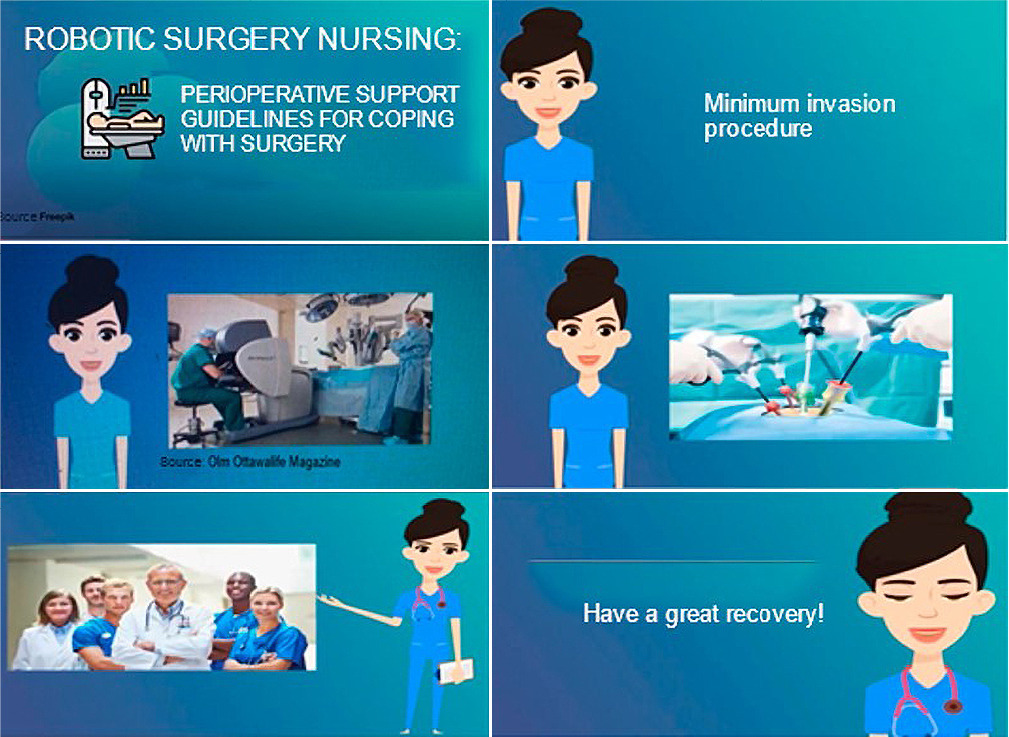
- Elisângela Maria Ribeiro Guimarães
-
ORIGINAL ARTICLE09-26-2022
Educational technology for infants’ families to identify warning signs: a validation study
- Icleia Parente Rodrigues
 ,
, - Patrícia Neyva da Costa Pinheiro
 ,
, - Edna Johana Mondragón-Sánchez
 ,
, - Maria Isabelly Fernandes da Costa
 ,
, - Paulo Henrique Alexandre de Paula
 , [ … ],
, [ … ], - Maria Veraci Oliveira Queiroz

Abstract
ORIGINAL ARTICLEEducational technology for infants’ families to identify warning signs: a validation study
Revista Brasileira de Enfermagem. 2022;75(5):e20210964
DOI 10.1590/0034-7167-2021-0964
- Icleia Parente Rodrigues
 ,
, - Patrícia Neyva da Costa Pinheiro
 ,
, - Edna Johana Mondragón-Sánchez
 ,
, - Maria Isabelly Fernandes da Costa
 ,
, - Paulo Henrique Alexandre de Paula
 ,
, - Joana Maria Rocha Sales
 ,
, - Larissa Ludmila Monteiro de Souza Brito
 ,
, - Maria Veraci Oliveira Queiroz

Views0See moreABSTRACT
Objective:
To validate, with the target audience, the usability and appearance of a serialized album about the warning signs to the health of children below 2 months.
Method:
Methodological validation study with the target population of an educational material in the form of a serialized album. 11 mothers with children under 2 months of age participated. The domains evaluated were: Objectives, Organization, Writing Style, Appearance, and Motivation. Data were analyzed using descriptive and statistics, and the data agreement index was calculated.
Results:
The global data agreement index was high (0.99). Mothers had positive responses, recognizing the excellence of the material: attractive figures that were easy to understand.
Conclusion:
The validation of the serialized album provides mothers with the abilities and knowledge they need to identify warning signs in regard to the health of their children, providing them with autonomy, corresponsibility, and helping them develop better child health practices.


This is an Open Access article distributed under the terms of the Creative Commons Attribution License, which permits unrestricted use, distribution, and reproduction in any medium, provided the original work is properly cited. 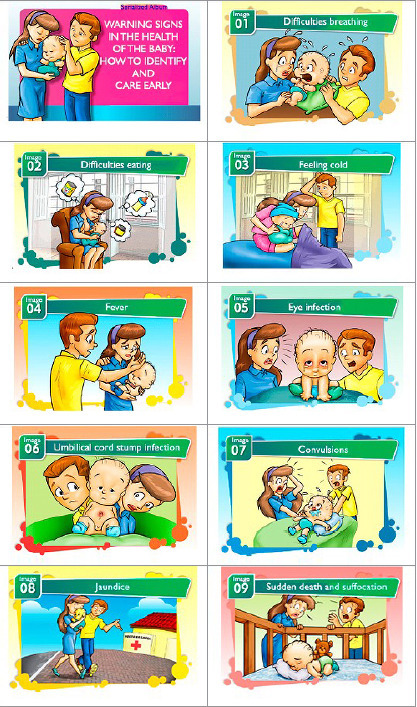
- Icleia Parente Rodrigues
-
ORIGINAL ARTICLE10-17-2022
Validation of the Brazilian Portuguese version of the Venous International Assessment Scale and proposal of revision
- Mayara Lopes
 ,
, - Julio César de la Torre-Montero
 ,
, - Maria Angélica Sorgini Peterlini
 ,
, - Mavilde da Luz Gonçalves Pedreira

Abstract
ORIGINAL ARTICLEValidation of the Brazilian Portuguese version of the Venous International Assessment Scale and proposal of revision
Revista Brasileira de Enfermagem. 2022;75(5):e20220100
DOI 10.1590/0034-7167-2022-0100
- Mayara Lopes
 ,
, - Julio César de la Torre-Montero
 ,
, - Maria Angélica Sorgini Peterlini
 ,
, - Mavilde da Luz Gonçalves Pedreira

Views0See moreABSTRACT
Objective:
To validate the Brazilian Portuguese translation and analyze the cultural adaptation of the Venous International Assessment Scale.
Methods:
Observational study by employing the Delphi technique and an equivalence evaluation by experts. The results were analyzed using item scores and by content validity index calculations of item, scale, and universal agreement.
Results:
Three rounds of evaluation were necessary for consensus. Explanatory contents were incorporated into the original scale throughout the process, resulting in a new version: VIA Scale – Revised. This scale obtained a content validity index of 0.96 and a universal agreement of 0.78. In the cross-cultural adequacy analysis phase, a score of 0.77 was obtained. The majority (90.5%) of the participants judged the scale’s decision support property as positive.
Conclusion:
The VIA Scale was validated and culturally adapted to the Brazilian Portuguese language, resulting in the VIA Scale – Revised (VIA-R).


This is an Open Access article distributed under the terms of the Creative Commons Attribution License, which permits unrestricted use, distribution, and reproduction in any medium, provided the original work is properly cited. - Mayara Lopes
-
ORIGINAL ARTICLE07-29-2022
Effects of guided imagery relaxation in hematopoietic stem-cell transplantation patients: a quasi-experimental study
- Luana Aparecida Alves da Silva
 ,
, - Paulo Ricardo Bittencourt Guimarães
 ,
, - Angela da Costa Barcellos Marques
 ,
, - Larissa Marcondes
 ,
, - Camila Schirmer Barbosa
 , [ … ],
, [ … ], - Luciana Puchalski Kalinke

Abstract
ORIGINAL ARTICLEEffects of guided imagery relaxation in hematopoietic stem-cell transplantation patients: a quasi-experimental study
Revista Brasileira de Enfermagem. 2022;75(5):e20220114
DOI 10.1590/0034-7167-2022-0114
- Luana Aparecida Alves da Silva
 ,
, - Paulo Ricardo Bittencourt Guimarães
 ,
, - Angela da Costa Barcellos Marques
 ,
, - Larissa Marcondes
 ,
, - Camila Schirmer Barbosa
 ,
, - Pâmela Cristine Piltz Costa
 ,
, - Luciana Puchalski Kalinke

Views1See moreABSTRACT
Objective:
To analyze the effects of the technique of virtual reality guided imagery in the vital signs of hematopoietic stem-cell transplantation patients.
Method:
Quasi-experimental study with 35 participants who received an intervention using virtual reality guided imagery with progressive muscle relaxation, applied three times a week for four weeks in a referral hospital for transplants in the south of Brazil. Data collected included: temperature, arterial pressure, respiratory rate, heart rate, pain, and oxygen saturation, before and after each intervention. The comparisons were analyzed using Wilcoxon’s test.
Results:
There was a clinical significance between the mean measurements before and after for respiratory rate (p=0.00) in all stages, and for the variables Heart rate, Temperature, and Oxygen saturation from the 1st to the 12th measurements (p=0.05).
Conclusion:
The intervention was low cost, easy to apply, and showed positive effects, presenting itself as an option for patient-focused care.


This is an Open Access article distributed under the terms of the Creative Commons Attribution License, which permits unrestricted use, distribution, and reproduction in any medium, provided the original work is properly cited. 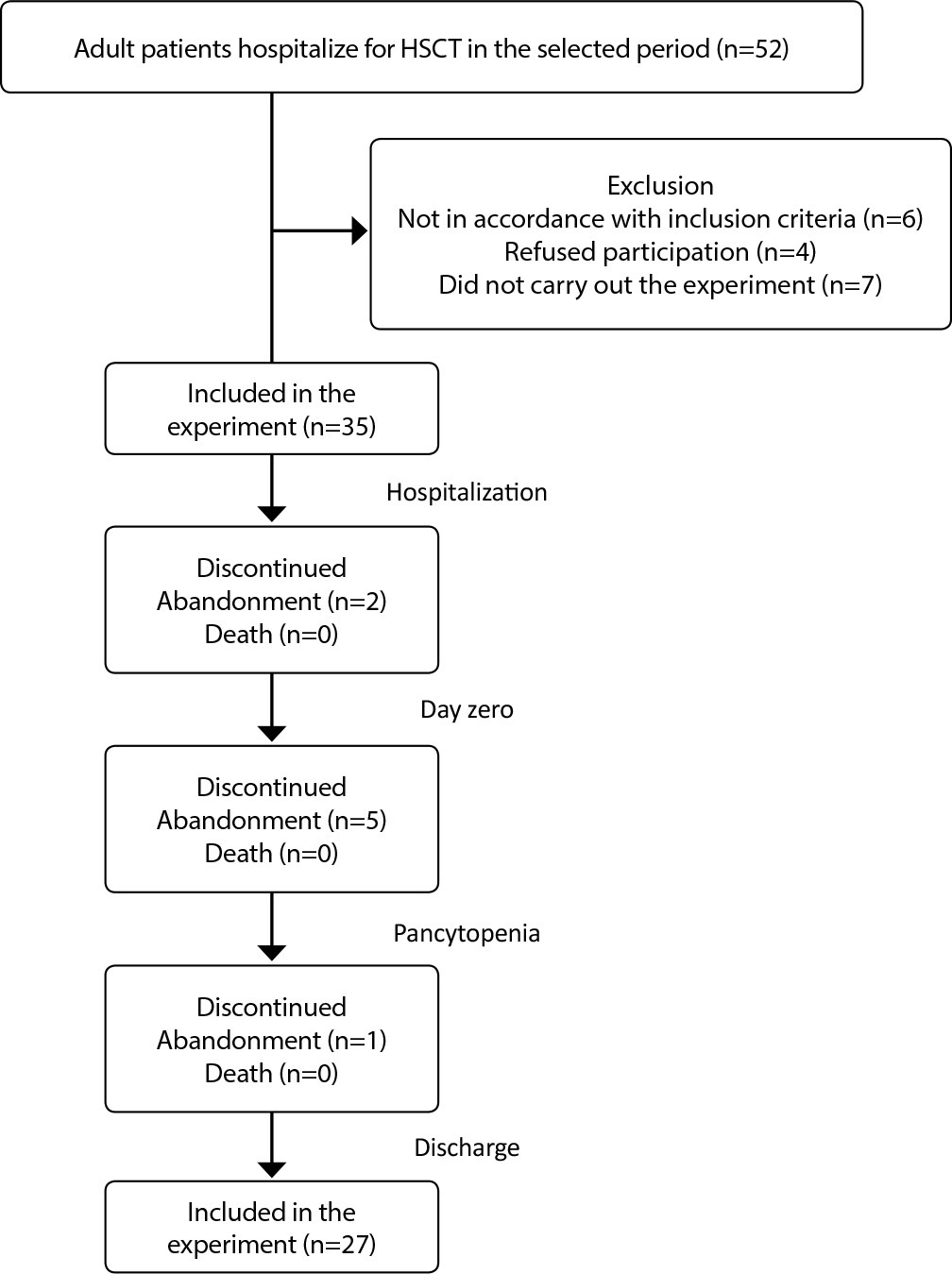
- Luana Aparecida Alves da Silva
-
ORIGINAL ARTICLE07-13-2020
Mental health of nursing in coping with COVID-19 at a regional university hospital
- Eduardo Bassani Dal’Bosco
 ,
, - Lara Simone Messias Floriano
 ,
, - Suellen Vienscoski Skupien
 ,
, - Guilherme Arcaro
 ,
, - Alessandra Rodrigues Martins
 , [ … ],
, [ … ], - Aline Cristina Correa Anselmo

Abstract
ORIGINAL ARTICLEMental health of nursing in coping with COVID-19 at a regional university hospital
Revista Brasileira de Enfermagem. 2020;73:e20200434
DOI 10.1590/0034-7167-2020-0434
- Eduardo Bassani Dal’Bosco
 ,
, - Lara Simone Messias Floriano
 ,
, - Suellen Vienscoski Skupien
 ,
, - Guilherme Arcaro
 ,
, - Alessandra Rodrigues Martins
 ,
, - Aline Cristina Correa Anselmo

Views0See moreABSTRACT
Objective:
to identify prevalence and factors associated with anxiety and depression in nursing professionals who work to cope with COVID-19 at a university hospital.
Methods:
a cross-sectional observational study using a sociodemographic questionnaire and Hospital Anxiety and Depression Scale, with 88 nursing professionals. Data were analyzed using absolute and relative frequency and Statistical Package for the Social Sciences.
Results:
there was prevalence of anxiety (48.9%) and depression (25%). The majority of the sample consisted of women over 40 years old, married or in a common-law marriage, white, with higher education or graduate degree, with an income above 3,000.00 reais, public servants, working 40 hours a week and working in the hospital from 1 to 5 years.
Conclusion:
we must consider the impact on mental health nursing caused by COVID-19 and intervene with coping strategies to minimize the suffering of professionals.


This is an Open Access article distributed under the terms of the Creative Commons Attribution License, which permits unrestricted use, distribution, and reproduction in any medium, provided the original work is properly cited. - Eduardo Bassani Dal’Bosco
-
REFLECTION04-22-2020
Thematic content analysis using ATLAS.ti software: Potentialities for researchs in health
Revista Brasileira de Enfermagem. 2020;73(3):e20190250
Abstract
REFLECTIONThematic content analysis using ATLAS.ti software: Potentialities for researchs in health
Revista Brasileira de Enfermagem. 2020;73(3):e20190250
DOI 10.1590/0034-7167-2019-0250
Views0See moreABSTRACT
Objective:
to describe the most important tools of ATLAS.ti Software and to associate them with the procedures of Thematic Content Analysis.
Method:
It is a theoretical reflection of the Content Analysis phases of Laurence Bardin, associating them with software tools Atlas.ti and showing its usefulness for data analysis in qualitative research.
Results:
historical contextualization and the available resources of Atlas.ti software with presentation of health research involving the phases of thematic content analysis.
Final considerations:
The Atlas.ti software assists in the accomplishment of the thematic content analysis being this promising association in health research.


This is an Open Access article distributed under the terms of the Creative Commons Attribution License, which permits unrestricted use, distribution, and reproduction in any medium, provided the original work is properly cited. 
-
REFLECTION10-26-2020
Nursing education: challenges and perspectives in times of the COVID-19 pandemic
- Ana Luisa Brandão de Carvalho Lira
 ,
, - Edlamar Kátia Adamy
 ,
, - Elizabeth Teixeira
 ,
, - Francisca Valda da Silva

Abstract
REFLECTIONNursing education: challenges and perspectives in times of the COVID-19 pandemic
Revista Brasileira de Enfermagem. 2020;73:e20200683
DOI 10.1590/0034-7167-2020-0683
- Ana Luisa Brandão de Carvalho Lira
 ,
, - Edlamar Kátia Adamy
 ,
, - Elizabeth Teixeira
 ,
, - Francisca Valda da Silva

Views0See moreABSTRACT
Objective:
To discuss the challenges and perspectives of nursing education in times of the COVID-19 pandemic.
Methods:
Reflection study, with theoretical approach based on national and international publications, allied to the experience of researchers in the area of nursing education.
Results:
Four sections are identified: Nursing education: current affairs and perspectives; Education and technologies in time of pandemic: acceleration, alteration and paralysis; Difference between emergency, intentional and remote teaching; the return to the “new normality”: new structuring axes and legal norms.
Final considerations:
The conclusion is that longstanding challenges have emerged with the pandemic, and the processes of acceleration, change and paralysis have marked education in these times. Moreover, epidemiological, technological and psychological aspects should be more valued in the return to activities.


This is an Open Access article distributed under the terms of the Creative Commons Attribution License, which permits unrestricted use, distribution, and reproduction in any medium, provided the original work is properly cited. - Ana Luisa Brandão de Carvalho Lira
-
ORIGINAL ARTICLE11-13-2020
Social determinants of health and COVID-19 infection in Brazil: an analysis of the pandemic
- Alexandre Medeiros de Figueiredo
 ,
, - Daniela Cristina Moreira Marculino de Figueiredo
 ,
, - Luciano Bezerra Gomes
 ,
, - Adriano Massuda
 ,
, - Eugenia Gil-García
 , [ … ],
, [ … ], - Antonio Daponte

Abstract
ORIGINAL ARTICLESocial determinants of health and COVID-19 infection in Brazil: an analysis of the pandemic
Revista Brasileira de Enfermagem. 2020;73:e20200673
DOI 10.1590/0034-7167-2020-0673
- Alexandre Medeiros de Figueiredo
 ,
, - Daniela Cristina Moreira Marculino de Figueiredo
 ,
, - Luciano Bezerra Gomes
 ,
, - Adriano Massuda
 ,
, - Eugenia Gil-García
 ,
, - Rodrigo Pinheiro de Toledo Vianna
 ,
, - Antonio Daponte

Views0See moreABSTRACT
Objective:
To analyze the influence of socioeconomic, demographic, epidemiological factors, and the health system structure in the evolution of the COVID-19 pandemic in Brazil.
Methods:
Ecological study with variables extracted from databases, having the incidence and mortality by COVID-19 until August 23, 2020, in Brazilian states, as response variables. The magnitude of the associations was estimated using Spearman’s correlation coefficient and multiple regression analysis.
Results:
In the Brazilian states, 59.8% of variation in the incidence of COVID-19 was justified by income inequality, significant home densification, and higher mortality. In the case of mortality, those same variables explained 57.9% of the country’s variations in federal units.
Conclusion:
Our results indicate that socioeconomic factors influenced the evolution and impact of COVID-19 in Brazil. Thus, we suggest comprehensive actions to ensure economic conditions and strengthening of health networks for populations with socioeconomic vulnerability.


This is an Open Access article distributed under the terms of the Creative Commons Attribution License, which permits unrestricted use, distribution, and reproduction in any medium, provided the original work is properly cited. - Alexandre Medeiros de Figueiredo
-
ORIGINAL ARTICLE02-27-2020
Prevalence of symptoms and quality of life of cancer patients
- Marina de Góes Salvetti
 ,
, - Caroline Silva Pereira Machado
 ,
, - Suzana Cristina Teixeira Donato
 ,
, - Adriana Marques da Silva

Abstract
ORIGINAL ARTICLEPrevalence of symptoms and quality of life of cancer patients
Revista Brasileira de Enfermagem. 2020;73(2):e20180287
DOI 10.1590/0034-7167-2018-0287
- Marina de Góes Salvetti
 ,
, - Caroline Silva Pereira Machado
 ,
, - Suzana Cristina Teixeira Donato
 ,
, - Adriana Marques da Silva

Views0See moreABSTRACT
Objectives:
to analyze the prevalence of symptoms and their relationship with the quality of life of cancer patients.
Methods:
this is a cross-sectional study with 107 patients evaluated using a sociodemographic instrument, the hospital anxiety and depression scale (HADS) and the quality of life scale (EORTC-QLQ-C30). Pearson’s correlation test was used to evaluate the relationship between symptoms and quality of life.
Results:
prevalence of female patients (56.1%), 55 years as the mean age and 10 years of schooling. Fatigue (76.6%), insomnia (47.7%), pain (42.1%), loss of appetite (37.4%), anxiety (31.8%) and depression (21.5%) were identified. Anxiety and depression symptoms presented a negative correlation with quality of life and positive correlation with physical symptoms.
Conclusions:
fatigue, insomnia, pain and loss of appetite were the most common and most intense symptoms. Anxiety and depression symptoms presented a negative correlation with quality of life and positive correlation with physical symptoms.


This is an Open Access article distributed under the terms of the Creative Commons Attribution License, which permits unrestricted use, distribution, and reproduction in any medium, provided the original work is properly cited. - Marina de Góes Salvetti
-
ORIGINAL ARTICLE08-10-2020
Braden Scale in pressure ulcer risk assessment
Revista Brasileira de Enfermagem. 2020;73(6):e20190413
Abstract
ORIGINAL ARTICLEBraden Scale in pressure ulcer risk assessment
Revista Brasileira de Enfermagem. 2020;73(6):e20190413
DOI 10.1590/0034-7167-2019-0413
Views0See moreABSTRACT
Objective:
To analyze the applicability of the Braden Scale to individuals admitted to an Intensive Care Unit (ICU) with the nursing diagnosis Impaired Physical Mobility, in its prediction potential to develop pressure ulcer (PU).
Methods:
A cross-sectional, quantitative study that evaluated all patients hospitalized in an ICU between November 2016 and February 2017, with the Braden Scale.
Results:
The prevalence of PU was 35.8% (24/67), in male individuals 58.3% (14/24), diagnosed with ischemic CVA 51.9% (12/27), and with hemorrhagic CVA 7.4% (2/27). Among patients classified at severe risk of developing pressure ulcer, 83.3% (20/53) developed it, and 76.7% (33/53) did not develop it.
Conclusion:
The performance of the Braden Scale showed a balance between sensitivity and specificity, confirming it as a better predictive risk assessment instrument in this group of patients.


This is an Open Access article distributed under the terms of the Creative Commons Attribution License, which permits unrestricted use, distribution, and reproduction in any medium, provided the original work is properly cited. -
REVIEW03-24-2021
Strategies of active learning methodologies in nursing education: an integrative literature review
- Joyce Fernanda Soares Albino Ghezzi
 ,
, - Elza de Fátima Ribeiro Higa
 ,
, - Monike Alves Lemes
 ,
, - Maria José Sanches Marin

Abstract
REVIEWStrategies of active learning methodologies in nursing education: an integrative literature review
Revista Brasileira de Enfermagem. 2021;74(1):e20200130
DOI 10.1590/0034-7167-2020-0130
- Joyce Fernanda Soares Albino Ghezzi
 ,
, - Elza de Fátima Ribeiro Higa
 ,
, - Monike Alves Lemes
 ,
, - Maria José Sanches Marin

Views0See moreABSTRACT
Objectives:
to analyze the scientific evidence on the strategies of active learning methodologies used in the training of nurses, as well as their contributions and obstacles in training.
Methods:
integrative literature review conducted with 33 selected articles in the Medical Literature Analysis and Retrieval System Online, Latin American and Caribbean Literature in Health Sciences, Nursing Database, Scopus, Web of Science and Education Resources Information Center databases.
Results:
among the strategies, simulation, problem-based learning and flipped classroom were highlighted. The active search, the integration of theory and practice and group work were examples of contributions to the training of nurses. However, the lack of preparation of the actors and the lack of structural support contribute to the dissatisfaction of the students.
Final Considerations:
the active learning methodology places the student at the heart of the learning process, favors critical thinking and the ability to make decisions.


This is an Open Access article distributed under the terms of the Creative Commons Attribution License, which permits unrestricted use, distribution, and reproduction in any medium, provided the original work is properly cited. - Joyce Fernanda Soares Albino Ghezzi
-
ORIGINAL ARTICLE09-16-2019
Validation of educational booklet: an educational technology in dengue prevention
- Camila Fernandes Wild
 ,
, - Elisabeta Albertina Nietsche
 ,
, - Cléton Salbego
 ,
, - Elizabeth Teixeira
 ,
, - Natalia Barrionuevo Favero

Abstract
ORIGINAL ARTICLEValidation of educational booklet: an educational technology in dengue prevention
Revista Brasileira de Enfermagem. 2019;72(5):1318-1325
DOI 10.1590/0034-7167-2018-0771
- Camila Fernandes Wild
 ,
, - Elisabeta Albertina Nietsche
 ,
, - Cléton Salbego
 ,
, - Elizabeth Teixeira
 ,
, - Natalia Barrionuevo Favero

Views0See moreABSTRACT
Objective:
to validate a booklet on dengue prevention in order to make it an educational technology to be used with the population.
Method:
methodological study, carried out with two groups of judges specialized in health and other areas. For data analysis, the calculation of Content Validity Index was carried out.
Results:
the booklet, in general, was considered valid by the expert judges, since it obtained an overall CVI of 70%. However, it has undergone a textual and aesthetic re-elaboration. The changes were based on the substitution of expressions, phrases, information additions and language adequacy. The illustrations were redone, adding clarity, expressiveness, movement, interaction and contextualization.
Conclusion:
the booklet is valid to be used for the population, with the purpose of informing, in a playful way, the forms of prevention and combat to mosquito transmitting dengue.


This is an Open Access article distributed under the terms of the Creative Commons Attribution License, which permits unrestricted use, distribution, and reproduction in any medium, provided the original work is properly cited. 
- Camila Fernandes Wild
Search
Search in:
Nuvem de Tags
Enfermagem (930)Cuidados de Enfermagem (269)Atenção Primária à Saúde (239)Idoso (208)Educação em Enfermagem (151)Segurança do Paciente (150)Saúde Mental (145)Educação em Saúde (139)Estudos de Validação (131)Qualidade de Vida (104)Tecnologia Educacional (100)Promoção da Saúde (99)COVID-19 (91)Criança (91)Família (87)Enfermagem Pediátrica (86)Saúde do Trabalhador (86)Adolescente (85)Saúde Pública (82)Estudantes de Enfermagem (77)


